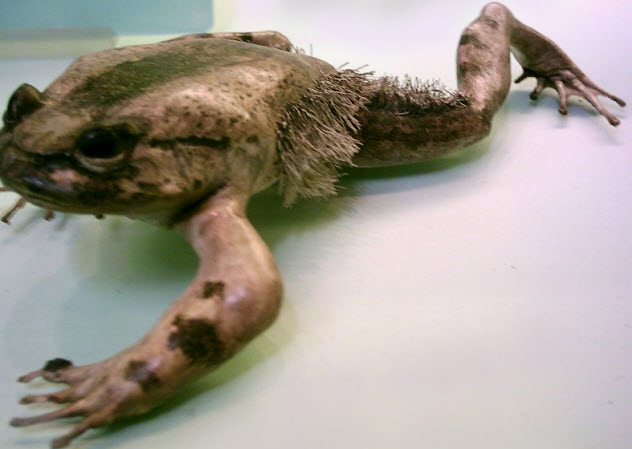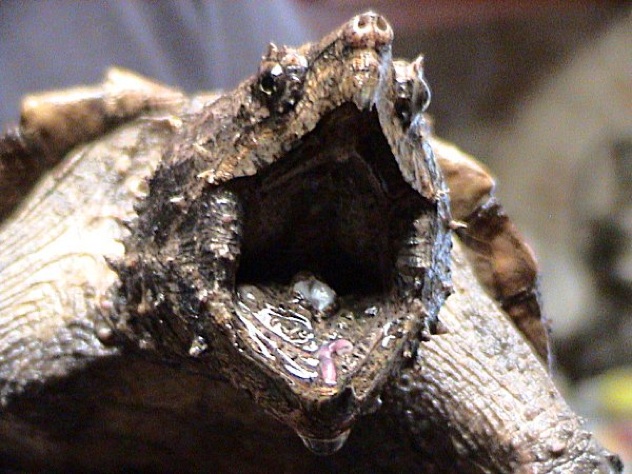 Politics
Politics  Politics
Politics  Weird Stuff
Weird Stuff Ten Bizarre Facts About The Doge Meme
 Our World
Our World 10 Ways Your Christmas Tree Is More Lit Than You Think
 Movies and TV
Movies and TV The 10 Coolest Stars to Set Sail on The Love Boat
 History
History 10 Things You Didn’t Know About the American National Anthem
 Technology
Technology Top 10 Everyday Tech Buzzwords That Hide a Darker Past
 Humans
Humans 10 Everyday Human Behaviors That Are Actually Survival Instincts
 Animals
Animals 10 Animals That Humiliated and Harmed Historical Leaders
 History
History 10 Most Influential Protests in Modern History
 Creepy
Creepy 10 More Representations of Death from Myth, Legend, and Folktale
 Politics
Politics 10 Political Scandals That Sent Crowds Into the Streets
 Weird Stuff
Weird Stuff Ten Bizarre Facts About The Doge Meme
 Our World
Our World 10 Ways Your Christmas Tree Is More Lit Than You Think
Who's Behind Listverse?

Jamie Frater
Head Editor
Jamie founded Listverse due to an insatiable desire to share fascinating, obscure, and bizarre facts. He has been a guest speaker on numerous national radio and television stations and is a five time published author.
More About Us Movies and TV
Movies and TV The 10 Coolest Stars to Set Sail on The Love Boat
 History
History 10 Things You Didn’t Know About the American National Anthem
 Technology
Technology Top 10 Everyday Tech Buzzwords That Hide a Darker Past
 Humans
Humans 10 Everyday Human Behaviors That Are Actually Survival Instincts
 Animals
Animals 10 Animals That Humiliated and Harmed Historical Leaders
 History
History 10 Most Influential Protests in Modern History
 Creepy
Creepy 10 More Representations of Death from Myth, Legend, and Folktale
10 Animals You Just Don’t Want to Mess With – 2020
We all know not to put up a middle finger at a polar bear. We all know not to tell a black widow that it’s got no friends. Would you hang around if you spilled your beer on a gorilla?
There are many animals we instinctively know not to mess with. Here’s list of some animals you may not know are dangerous, gross or generally hostile to us two-legged pig-monkeys. Mess with them at your own peril!
10 Animals That Use Bizarre Methods To Kill Their Prey
10 Hairy Frogs

Perhaps the most metal animal ever, the hairy frog doesn’t just look like the type of amphibian that’d be first into the mosh pit at a Slayer gig, but it has a very interesting defence mechanism when it feels threatened. It breaks its own legs.
Whenever these little mad-lads are being attacked or picked up by uncaring biologists seeking to study them in their native Central African forests, they push a bony spur through the skin of their feet by breaking the nodule that sheaths it. Like a non-healing Wolverine from X-men. So why would humans not mess with them, they aren’t dangerous? Well, would you want to be responsible for letting a harmless little frog break their own feet in fear? Please say no…[1]
9 Capercaillies

If you were fancying pilfering a little egg or two for your supper, you’d probably pick a bird like the capercaille to steal from. They’re a sort of grouse, so not that bright, plus they’re heads point upwards, making it look as though they’re doing a spot of stargazing. But don’t be fooled by these fat little beasties comical visage, they’ll kick your ass up and down the forest!
Male Western Capercaillies display heightened territoriality and aggression during mating season, often willing to fight all comers, including unlucky bird-watchers who get to close. It seems that this behaviour isn’t all male capercaillies, however. A study that tracked behaviour in the more ‘deviant’ birds (males known to attack humans), conducted in Southern Finland, found that these males showed testosterone levels five times higher than the baseline. It could be the effect of ‘negative sexual imprinting’, ‘abnormal sex hormone distribution’ or ‘underground capercaillie steroid use in the locker rooms of Finland’s avian gyms’… Ok, the last reason was fake.[2]
8 Moray Eels

Going toe-to-toe with the angler fish for the title of ‘the ocean’s scariest looking denizen’, moray eels are pretty horrifying animals. They hang around near reefs and rocky parts of shallow waters, ready to snatch any passing prey. Sometimes, a diver’s hand looks like an unwitting crustacean to a moray eel. You can see where I’m going here.
With many of the 200 different species possessing some incredibly awful-looking, needle-like teeth, one can imagine that a bite from one of these dead-eyed monsters would be quite unpleasant. Given that they’re teeth are arranged in a backwards-facing fashion, causing a ‘rip’ like bite, and given that their mucous contains two sorts of nasty venom that causes red blood cells to both clump and eventually get destroyed, maybe calling their bite ‘unpleasant’ was a bit of an understatement.
Plus, look at their face! Ugh.[3]
7 Tiger Centipede
Swelling, redness, itching, possible anaphylaxis and tissue necrosis – all standard fare for a nip from a creepy crawler. So what makes a bite from the giant desert centipede (also known as the tiger centipede) any different from, say, a bumblebee sting?
The pain. Sweet mother of mercy. The pain!
Naturalist Coyote Peterson (great name), has become a bit of a legend in the world of ‘people doing dangerous things in the name of progress’ by working his way through the list of ‘Insect Sting Pain Index’, AKA ‘The Schmidt Pain Index’, named after entomologist Justin Schmidt. Why is it named after him? Because he did the same thing Coyote did – wilfully subject himself to a series of bug stings in the name of science.
People will often think of the bullet ant or tarantula hawk wasp as the worst pain-givers in the insect world. Not according to Coyote Peterson: “This just absolutely eclipses all the insect stings I’ve taken “. Frankly, I believe him.[4]
6 Australian Magpies

I don’t know about you, dear reader, but where I’m from, magpies are intelligent, beautiful birds that’ll pinch any shiny objects it finds to fly back to their nests. Not down under. There, they are a dangerous menace.
Australian magpies seem to have developed a pathological hatred of humans who walk within a few feet of their nest. As a result, these black & white blighters have resolved to dive bomb anybody who wanders within their proximal zone of protection. Especially cyclists. This year alone there have been over 3000 attacks on humans by magpies in Australia, with 399 people receiving injuries (not just a jump scare as they commute to work through the park).[5]
Top 10 Surreal Animals That Really Exist
5 Camel Spiders

These Middle Eastern monstrosities are so completely nightmarish that they have inspired urban legends! Ok, so they may not inject unwitting victims with a local anaesthetic to use their huge mandibles to cut coin-sized holes in your torso to burrow inside and eat your guts from within – but they are creepy little arachnids that could give you one hell of a bite and a hell of a fright.
Whilst looking like a cross between a giant scorpion and a spider may be enough to send most people screaming for their mother, they do possess one unusual property that make them well placed on this list. They’re horrifyingly fast! Maybe not quick enough to catch a reasonably fit and healthy person sprinting at full tilt, but clocking in at an impressive 10 MPH, you better hope your ankle remains un-strained.[6]
4 Alligator Snapping Turtle

Due to a seemingly perpetual exotic animal trade, human beings are often found in possession of some pretty dangerous animals. When we consider that this large turtle is one of them, you may think ‘What? It’s a turtle. Minus some ninja weapons and a rat sensei, they’re slow and cute!’ Wrong. According to Thomas Coy of ‘Austins Turtle Page’ (a website for turtle enthusiasts and keepers), these gigantic beasts aren’t even suited for many experienced handlers.
The alligator snapping turtle has one of the most powerful bites in the animal kingdom, measuring in at a whopping 1000 psi (pounds per square inch), they’re not to be underestimated – the great white shark has a bite force of 625 psi. They may not be in the same league as the jaguar (1350 psi), gorilla (1300 psi) or a crocodile (3700 psi), but nobody would ever try to give one of these animals a cuddle. A friendly little turtle though? If you want to give it a go, prepare to say bye-bye to your thumbs.[][7]
3 Giant Anteaters

Aww!
These guys are even cuter than the turtles. Until you look at those claws. And especially if you know how they fight when threatened. Giant anteaters rear up, lift their claws and swipe, leaving anybody unlucky enough to face off with these Central/South American animals thinking ‘so THAT’S what my guts look like’.
In 2010 and 2012 respectively, two Brazilian hunters were killed by anteaters. Both instances prompted alarm as to the loss of the creatures habitat, possibly indicating that an increase in such encounters may be on the cards. In 2009, an Argentine zookeeper was mauled to death whilst she was inside the enclosure with a particularly aggressive anteater. The ancient Aztecs considered the animal a comical, trickster-like figure whilst surrealists like Dali and animator Max Fleischer also pointed to the animal’s strange look. Never forget the claws…[8]
2 Assassin Bugs

The clue is in the name. These bugs are often listed as one of the top animals that cause human deaths. But they’re mostly just an annoyance – they’re bite is irritating and itchy. Some species display the macabre behaviour of wearing the corpses of their vanquished foe, attaching the body of the murdered bug to their back which is covered in a sticky substance. So how do they kill people?
Whilst most assassin bugs don’t kill people, the inappropriately-named ‘Kissing Bug’ (rhodnius prolixus) is a species that lives in South America that carries the parasitic protozoan that cases Chagas disease. The illness affects around 7 million people, mostly in South America, and can lead to serious heart problems, neurological disorders and early death.[9]
1 Sloths

We’ve had a look at some really awful-looking animals and some cuties. The sloths of the world tend to split people in terms of how they are perceived – some people find them utterly adorable, others find them creepy and weird-looking. Whatever you may think of them, you don’t want to mess with a wild specimen. Is it that, despite their languid movements, every sloth is hiding a switchblade under their fur? Of course not, but there is something else hidden in their fur.
A whole lot of bugs and larvae and mites and a ton of ungodly stank.
Moths, mites, a stinking green algae and, on one specimen, around 980 scarab beetles all make their home on the body of this slow-moving tree-hanger. If you add this to the fact that whenever a sloth poops it evacuates a third of its own body weight in faecal matter, sloths may be the grossest animal in the world. On the plus side, that gross algae may harbour a type of fungus that will end up curing cancer. We need to start raising money to provide sloth biologists with clothes pegs for their noses…[10]
10 Times Wild Animals Saved Humans








